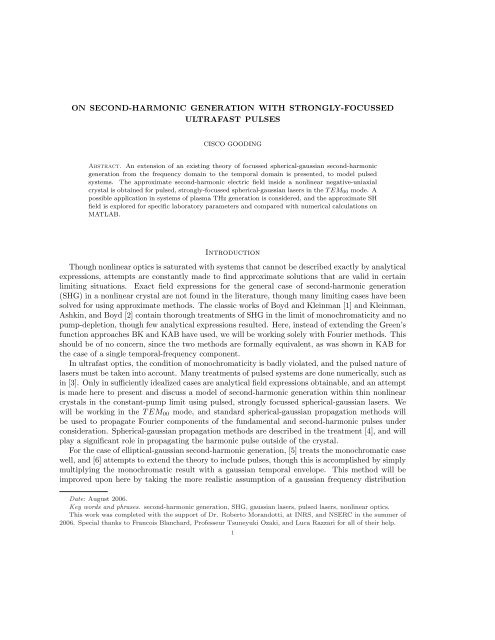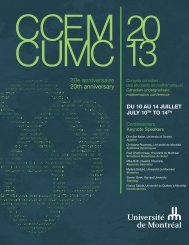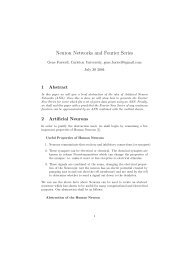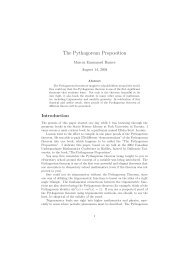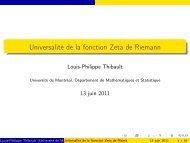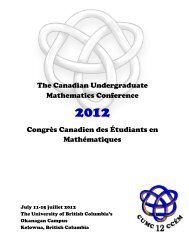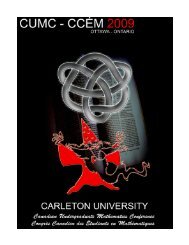on second-harmonic generation with strongly-focussed ... - CUMC
on second-harmonic generation with strongly-focussed ... - CUMC
on second-harmonic generation with strongly-focussed ... - CUMC
Create successful ePaper yourself
Turn your PDF publications into a flip-book with our unique Google optimized e-Paper software.
ON SECOND-HARMONIC GENERATION WITH STRONGLY-FOCUSSEDULTRAFAST PULSESCISCO GOODINGAbstract. An extensi<strong>on</strong> of an existing theory of <strong>focussed</strong> spherical-gaussian sec<strong>on</strong>d-harm<strong>on</strong>icgenerati<strong>on</strong> from the frequency domain to the temporal domain is presented, to model pulsedsystems. The approximate sec<strong>on</strong>d-harm<strong>on</strong>ic electric field inside a n<strong>on</strong>linear negative-uniaxialcrystal is obtained for pulsed, str<strong>on</strong>gly-<strong>focussed</strong> spherical-gaussian lasers in the T EM 00 mode. Apossible applicati<strong>on</strong> in systems of plasma THz generati<strong>on</strong> is c<strong>on</strong>sidered, and the approximate SHfield is explored for specific laboratory parameters and compared <strong>with</strong> numerical calculati<strong>on</strong>s <strong>on</strong>MATLAB.Introducti<strong>on</strong>Though n<strong>on</strong>linear optics is saturated <strong>with</strong> systems that cannot be described exactly by analyticalexpressi<strong>on</strong>s, attempts are c<strong>on</strong>stantly made to find approximate soluti<strong>on</strong>s that are valid in certainlimiting situati<strong>on</strong>s. Exact field expressi<strong>on</strong>s for the general case of sec<strong>on</strong>d-harm<strong>on</strong>ic generati<strong>on</strong>(SHG) in a n<strong>on</strong>linear crystal are not found in the literature, though many limiting cases have beensolved for using approximate methods. The classic works of Boyd and Kleinman [1] and Kleinman,Ashkin, and Boyd [2] c<strong>on</strong>tain thorough treatments of SHG in the limit of m<strong>on</strong>ochromaticity and nopump-depleti<strong>on</strong>, though few analytical expressi<strong>on</strong>s resulted. Here, instead of extending the Green’sfuncti<strong>on</strong> approaches BK and KAB have used, we will be working solely <strong>with</strong> Fourier methods. Thisshould be of no c<strong>on</strong>cern, since the two methods are formally equivalent, as was shown in KAB forthe case of a single temporal-frequency comp<strong>on</strong>ent.In ultrafast optics, the c<strong>on</strong>diti<strong>on</strong> of m<strong>on</strong>ochromaticity is badly violated, and the pulsed nature oflasers must be taken into account. Many treatments of pulsed systems are d<strong>on</strong>e numerically, such asin [3]. Only in sufficiently idealized cases are analytical field expressi<strong>on</strong>s obtainable, and an attemptis made here to present and discuss a model of sec<strong>on</strong>d-harm<strong>on</strong>ic generati<strong>on</strong> <strong>with</strong>in thin n<strong>on</strong>linearcrystals in the c<strong>on</strong>stant-pump limit using pulsed, str<strong>on</strong>gly <strong>focussed</strong> spherical-gaussian lasers. Wewill be working in the T EM 00 mode, and standard spherical-gaussian propagati<strong>on</strong> methods willbe used to propagate Fourier comp<strong>on</strong>ents of the fundamental and sec<strong>on</strong>d-harm<strong>on</strong>ic pulses underc<strong>on</strong>siderati<strong>on</strong>. Spherical-gaussian propagati<strong>on</strong> methods are described in the treatment [4], and willplay a significant role in propagating the harm<strong>on</strong>ic pulse outside of the crystal.For the case of elliptical-gaussian sec<strong>on</strong>d-harm<strong>on</strong>ic generati<strong>on</strong>, [5] treats the m<strong>on</strong>ochromatic casewell, and [6] attempts to extend the theory to include pulses, though this is accomplished by simplymultiplying the m<strong>on</strong>ochromatic result <strong>with</strong> a gaussian temporal envelope. This method will beimproved up<strong>on</strong> here by taking the more realistic assumpti<strong>on</strong> of a gaussian frequency distributi<strong>on</strong>Date: August 2006.Key words and phrases. sec<strong>on</strong>d-harm<strong>on</strong>ic generati<strong>on</strong>, SHG, gaussian lasers, pulsed lasers, n<strong>on</strong>linear optics.This work was completed <strong>with</strong> the support of Dr. Roberto Morandotti, at INRS, and NSERC in the summer of2006. Special thanks to Francois Blanchard, Professeur Tsuneyuki Ozaki, and Luca Razzari for all of their help.1
2 CISCO GOODINGmodified by the frequency-dependent m<strong>on</strong>ochromatic result, which results in a temporal envelopethat has a richer structure than a pure gaussian.However, since we will be focussing <strong>on</strong> thin crystals, we will ignore spatial walk-off and groupvelocity dispersi<strong>on</strong> (GVD), which are negligible in this limit. A sample system will be discussed,very similar to those described in [9] and [10], which is a possible applicati<strong>on</strong> of the field expressi<strong>on</strong>sobtained. This system has a four-wave mixing process known as THz generati<strong>on</strong> occurring in plasmacreated by str<strong>on</strong>gly-<strong>focussed</strong> gaussian laser pulses (a fundamental and a sec<strong>on</strong>d-harm<strong>on</strong>ic pulse).1. Sec<strong>on</strong>d-Harm<strong>on</strong>ic Generati<strong>on</strong> in the Frequency DomainWe begin <strong>with</strong> an established theory of Type I sec<strong>on</strong>d-harm<strong>on</strong>ic generati<strong>on</strong> applicable to c<strong>on</strong>tinuouswavegaussian lasers, including <strong>on</strong>ly <strong>on</strong>e frequency value. This treatment closely follows the <strong>on</strong>efound in the celebrated text “N<strong>on</strong>linear Optics” by Robert W. Boyd [7]. The sec<strong>on</strong>d-harm<strong>on</strong>ic fieldoscillates at a frequency 2ω 1 , <strong>with</strong> ω 1 being the frequency of the fundamental field, and can bedescribed by the inhomogeneous paraxial wave equati<strong>on</strong>(1) 2ik 2∂A 2 (r, z, ω 1 )∂z+ ∇ 2 t A 2 (r, z, ω 1 ) = −4πω 2c 2 χ (2) A 1 (r, z, ω 1 ) 2 e i∆kz ,where A 1 (r, z, ω 1 ) and A 2 (r, z, ω 1 ) are the slowly-varying amplitudes of the fundamental and sec<strong>on</strong>dharm<strong>on</strong>icfrequency fields, respectively, and ∆k is the wave-vector mismatch between the input(fundamental) and polarizati<strong>on</strong> (harm<strong>on</strong>ic) fields. Since we have a fixed geometry, χ (2) is theeffective susceptibility tensor. All expressi<strong>on</strong>s use the Gaussian system of units. It is evident thatpropagati<strong>on</strong> is al<strong>on</strong>g the z-axis, and in the c<strong>on</strong>stant-pump limit we can use an uncoupled soluti<strong>on</strong> ofthe homogeneous paraxial wave equati<strong>on</strong> to formulate a trial soluti<strong>on</strong> for the sec<strong>on</strong>d-harm<strong>on</strong>ic field<strong>with</strong> a similar structure. The uncoupled homogeneous soluti<strong>on</strong>, which will serve as our fundamentalfield <strong>with</strong>in the n<strong>on</strong>linear material, is given by(Â 1 (ω 1 )(2) A 1 (r, z, ω 1 ) =1 + iζ(z, ω 1 ) exp −r 2 )w0 2[1 + iζ(z, ω ,1)]where ζ(z, ω 1 ) ≡ 2z/b(ω 1 ), and the c<strong>on</strong>focal parameter b(ω 1 ) ≡ k(ω 1 )w0. 2 The radial coordinate rrepresents the distance from the z-axis, k(ω 1 ) is the spatial frequency, and w 0 is the 1/e radius atthe beam waist. Equati<strong>on</strong>s (1) and (2) suggest to the harm<strong>on</strong>ic field expressi<strong>on</strong>s(3) A 2 (r, z, ω 1 ) = Â2(z, (ω 1 )1 + iζ(z, ω 1 ) exp −2r 2 )w0 2[1 + iζ(z, ω 1)]and(4) Â 2 (r, z, ω 1 ) = 4πiω ∫ z1n(ω 1 )c χ(2) Â 1 (ω 1 ) 2 e i∆kz′ dz ′z 01 + iζ(z ′ , ω 1 ) ,The z ′ integral begins at the locati<strong>on</strong> of the closest face of the crystal, z 0 , and runs until a z value<strong>with</strong>in the crystal.This integral cannot be solved analytically, but it is interesting to c<strong>on</strong>sider the case of perfectphase-matching, in which ∆k vanishes and the sec<strong>on</strong>d-harm<strong>on</strong>ic generated <strong>with</strong>in the n<strong>on</strong>linearmaterial travels <strong>with</strong> the same phase-velocity as the fundamental. This c<strong>on</strong>diti<strong>on</strong> is often achievedin optical systems that use negative uniaxial crystals. In this case the integral in equati<strong>on</strong> (4) is asimple logarithm and we have a completely analytical expressi<strong>on</strong> for the sec<strong>on</strong>d-harm<strong>on</strong>ic electricfield - if, that is, we have <strong>on</strong>ly <strong>on</strong>e frequency in the spectrum of the fundamental pulse. For ultrafast
ON SECOND-HARMONIC GENERATION WITH STRONGLY-FOCUSSED ULTRAFAST PULSES 3optical systems of shorter and shorter temporal extent, there are broader and broader distributi<strong>on</strong>sof frequencies, and we must take into account field c<strong>on</strong>tributi<strong>on</strong>s from each of these frequencies.2. The Complete Sec<strong>on</strong>d-Harm<strong>on</strong>ic Field2.1. Gaussian Frequency Distributi<strong>on</strong>s and Dispersi<strong>on</strong>. Assuming a gaussian spread of frequenciesin the spectrum of the fundamental pulse, which laser systems often display, we can obtainthe complete spatiotemporal harm<strong>on</strong>ic field. From the definiti<strong>on</strong> of the slowly-varying amplitude,(5) E 2,tot (r, z, t) =∫ ∞ω=0A 2 (r, z, ω)e ik′ (2ω)z−2ωt dω + c.c.,where ω is the c<strong>on</strong>tinuous frequency variable of the fundamental pulse, which has a spectrumcentered at ω 1 . This amounts to a Fourier transform, <strong>with</strong> the extra c<strong>on</strong>diti<strong>on</strong> A ∗ 2(r, z, −ω) =A 2 (r, z, ω), to ensure that the electric field will be real. The gaussian frequency distributi<strong>on</strong> entersequati<strong>on</strong> (4) in the fundamental field amplitude:(6) Â 1 (ω) = Be −σ·(ω−ω1)2 .The quantity B is related to the energy of the fundamental pulse, and σ is related to the frequencybandwidth.To take into account dispersi<strong>on</strong> (though <strong>on</strong>ly to first order in ω), we can write the spatialfrequencies of the fundamental and harm<strong>on</strong>ic fields as(7) k(ω) ≃ k 0 + k 1 · (ω − ω 1 )and(8) k ′ (2ω) ≃ k ′ 0 + k ′ 1 · (2ω − 2ω 1 ),respectively. The quantities k 1 and k ′ 1 are the inverse group velocities of the pulses. Note also thatthe fundamental dispersi<strong>on</strong> power series is expanded around ω 1 , whereas the harm<strong>on</strong>ic is expandedaround 2ω 1 .The logarithmic soluti<strong>on</strong> to equati<strong>on</strong> (4) describes the growing amplitude of the harm<strong>on</strong>ic pulseas it is generated by the fundamental pulse <strong>with</strong>in the crystal. However, perfect phase-matchingcannot occur at every frequency. If there is a group velocity mismatch between the fields, then thelogarithmic soluti<strong>on</strong> of the integral in equati<strong>on</strong> (4) is not exact, though it is still a fine approximati<strong>on</strong>if the peak frequencies are phase-matched and the group velocity mismatch is not too extreme.The approximati<strong>on</strong>s thus far work best in the limit of very thin crystals, which are often usedto avoid spatial and temporal walk-off effects, as well as pulse broadening. This case suites ourpurposes since we have explicitly neglected group velocity dispersi<strong>on</strong>, which is resp<strong>on</strong>sible for pulsebroadening, by truncating the dispersi<strong>on</strong> power series’ before the quadratic terms.2.2. Integrand Approximati<strong>on</strong>s. Putting the pieces together and noting that the index of refracti<strong>on</strong>n(ω) = k(ω)c/ω, we obtain an integral expressi<strong>on</strong> for the (complex) harm<strong>on</strong>ic field:∫ ∞ω 2 e −2σ(ω−ω ( )1) 21 + iζ(z, ω)Ẽ 2,tot = ξln0 1 + iζ(z, ω) 1 + iζ(z 0 , ω)(9)(−2r 2)· expw0 2[1 + iζ(z, ω)] + i[k′ (2ω)z − 2ωt] dω.Here, the field arguments were suppressed and a c<strong>on</strong>stant ξ ≡ 2πB2 w 2 0cχ (2) was defined for brevity.2Our coordinate system has the focus of the beam at the origin, and to simplify matters we will
4 CISCO GOODINGassume that all frequency comp<strong>on</strong>ents focus at approximately the same positi<strong>on</strong> al<strong>on</strong>g the z-axis(z = 0). It should be menti<strong>on</strong>ed that since we are working in the c<strong>on</strong>stant-pump limit, in whichlosses are negligible, we are necessarily well below res<strong>on</strong>ant frequencies of the n<strong>on</strong>linear materialand thus the effective susceptibility tensor is independent of frequency and can be safely pulledoutside the integral.Again, however, this integral cannot be solved analytically, but there are limiting cases wherewe can apply approximati<strong>on</strong>s to obtain more manageable expressi<strong>on</strong>s. If we restrict our attenti<strong>on</strong>to pulses that are str<strong>on</strong>gly <strong>focussed</strong> <strong>with</strong>in the material, then the c<strong>on</strong>focal parameter b(ω) satisfies(10) b(ω) ≪ |z|, ∀z ∈ [z 0 , z 0 + L],where L is the length of the crystal. It is clear that the str<strong>on</strong>g-focussing c<strong>on</strong>diti<strong>on</strong> cannot be appliedat the focal point of the pulse, where z = 0, regardless of arbitrarily small c<strong>on</strong>focal parameters.Since we are working <strong>with</strong> very thin crystals, we need <strong>on</strong>ly to have an offset between the positi<strong>on</strong>of the crystal and the focal point of the pulse (which is ideal for the sample system to be discussed)to safely apply this c<strong>on</strong>diti<strong>on</strong>.With this in mind, we can use the c<strong>on</strong>diti<strong>on</strong> in equati<strong>on</strong> (10) to rewrite the logarithm in equati<strong>on</strong>(9) from the frequency integral as(11) ln( 1 + iζ(z, ω)1 + iζ(z 0 , ω))( ) ( )1 + 2iz/b(ω) z= ln≈ ln .1 + 2iz 0 /b(ω) z 0Since this is independent of frequency, we are free to pull the logarithm out of the frequency integraland absorb it into the c<strong>on</strong>stant ξ, which will now be denoted by ξ ′ (z).We can now write the integral in equati<strong>on</strong> (9) in a more transparent form by introducing twodummy variables, α and β, and differentiating them under the integral sign such that(12) Ẽ 2,tot = ξ ′′ ∂ 2 ∫ ∞((r, z)∂α∂β | α,β=1 e −2σ·(αω2 −2ωω 1)+2iω·(k ′ 1 z−t) −2βr 2 )expw0 2[1 + iζ(z, ω)] dω,where again ξ has been redefined as(13) ξ ′′ (r, z) ≡ ξ ′ (z)0( ) w20e −2σω2 1 +iz·(k′ 0 −2k′ 1 ω1) ,4σrto take care of c<strong>on</strong>stants and terms brought down by differentiati<strong>on</strong>.This integral would be solvable, if it weren’t for the ζ term. Using the definiti<strong>on</strong> of ζ, we canwrite the offending term as(14)11 + iζ(z, ω) ≡ 11 + 2iz/b(ω) = b(ω)/2iz1 + b(ω)/2iz .The c<strong>on</strong>diti<strong>on</strong> in (10) also allows us to expand the denominator of equati<strong>on</strong> (14) in a powerseries, and truncate the result to first order, leaving us <strong>with</strong>1(15)1 + iζ(z, ω) ≈ b(ω) (2iz · 1 − b(ω) ).2izMaking use of the approximati<strong>on</strong> in equati<strong>on</strong> (15) and the fact that b(ω) ≡ k(ω)w 2 0, equati<strong>on</strong>(12) becomes(16) Ẽ 2,tot ≈ ξ ′′ (r, z)∂α∂β | α,β=1I ω ,∂ 2
ON SECOND-HARMONIC GENERATION WITH STRONGLY-FOCUSSED ULTRAFAST PULSES 5<strong>with</strong> the definiti<strong>on</strong>s∫ ∞[ iβr(17) I ω ≡ e −2σαω2 +2ωφ(z,t) 2 [k 0 + k 1 · (ω − ω 1 )]expz0and (to describe axial wave propagati<strong>on</strong> and take care of a c<strong>on</strong>stant)(18) φ(z, t) ≡ i · (k ′ 1z − t) + 2σω 1 .(· 1 + i[k 0 + k 1 · (ω − ω 1 )]w02 )]dω2zThe integral we have arrived at in equati<strong>on</strong> (17) is a simple gaussian, but in order to solve it <strong>with</strong>outthe aid of an error functi<strong>on</strong> we can simply extend the lower-bound <strong>on</strong> the integrati<strong>on</strong> range to −∞,which is valid even for large frequency bandwidths provided ∆ω/ω 1 ≪ 1.2.3. An Analytical Soluti<strong>on</strong>. When all the dust settles, the (complex) sec<strong>on</strong>d-harm<strong>on</strong>ic field weare left <strong>with</strong> is((19) Ẽ 2,tot ≈ ˆξ(r, r 2ˆk )· (2iz − w 2z)P (r, z, t) exp0ˆk)2z 2 + (2z2 φ + k 1 r 2 [iz − w0ˆk]) 2 22k1 2r2 w0 2z2 + 8z 4 ,σwhere(20) ˆk ≡ k0 − k 1 ω 1 ,z(21) ˆξ(r, 3 (2π) 3/2 B 2 w 4 ( )z) ≡0z4c 2 (k1 2r2 w0 2 + 4z2 σ) 9/2 χ(2) ln e −2σω2 1 +iz·(k′ 0 −2k′ 1 ω1) ,z 0and(22)P (r, z, t) ≡ 5(k 2 1r 2 w 2 0 + 4σz 2 ){k 4 1r 4 w 2 0 + k 2 1r 2 (k 2 1w 4 0 + 8z 2 σ)+ 4z 2 [4ik 1 σ(ik 0 w 2 0 + z)(2σω 1 − φ) + 4k 0 σ 2 (k 0 w 2 0 − 2iz) + k 2 1w 2 0(σ + (2σω 1 − φ) 2 )]}+ 1 z 2 {[k4 1r 2 w 2 0(r 2 + w 2 0) + 16ik 1 z 2 σ(z + ik 0 w 2 0)(2σω 1 − φ) + 16k 0 z 2 σ 2 (k 0 w 2 0 − 2iz)+ 4k 2 1z 2 (w 2 0(2σω 1 − φ) 2 + σ(2r 2 + w 2 0))] · [r 2 k 1 (iz + k 1 ω 1 w 2 0 − k 0 w 2 0) + 2z 2 φ] 2 }− 2(k 2 1r 2 w 2 0 + 4z 2 σ) 2 [8k 0 σ(k 0 w 2 0 − 2iz) + 4ik 1 (ik 0 w 2 0 + z)(4σω 1 − φ)+ k 2 1{2r 2 + w 2 0(1 − 4ω 1 (φ − 2σω 1 ))}].To obtain the real electric field, we merely add the complex c<strong>on</strong>jugate of this, as dictated by equati<strong>on</strong>(5).There appears to be significant mixing of space and time throughout the harm<strong>on</strong>ic field expressi<strong>on</strong>,which has quite a rich structure that dictates the amplitude, phase, curvature, dimensi<strong>on</strong>s andpropagati<strong>on</strong> of the growing harm<strong>on</strong>ic pulse. Some aspects of this structure will be explored in oursample system. It is clear that all time dependence is c<strong>on</strong>tained in the propagati<strong>on</strong> term, φ(z, t),which primarily describes movement of the pulse at the group velocity (al<strong>on</strong>g the z-axis).A similar, though simpler, procedure can be applied to the m<strong>on</strong>ochromatic spherical-gaussianof equati<strong>on</strong> (2) to obtain the approximate electric field of the fundamental pulse. This pulse hasa different dispersi<strong>on</strong> relati<strong>on</strong>, reflected by the differences of equati<strong>on</strong>s (7) and (8), and so willpropagate at a different group velocity. Depending <strong>on</strong> the extent of group velocity mismatch, thefields obtained using the above methods can <strong>on</strong>ly safely be applied for crystals of certain lengths.As the pulses propagate through the crystal, their peaks begin to separate, and it becomes less
6 CISCO GOODINGaccurate to assume that the harm<strong>on</strong>ic c<strong>on</strong>tinues to be generated <strong>with</strong> the same structure as itwould if the peaks remained together. Specifically, we may restrict crystal lengths according to∆t(23) L ≤M|k 1 − k 1 ′ |,for some positive integer M, if we want our pulses to separate at most ∆t/M while <strong>with</strong>in thecrystal, where ∆t is the fundamental pulse (temporal) width. Then, satisfying the inequality forhigher values of M corresp<strong>on</strong>ds to a better approximati<strong>on</strong>.One may now wish to find the fields outside the crystal, but the above methods <strong>on</strong>ly describethe fields <strong>on</strong> the inside. Outside, both the fundamental field and the harm<strong>on</strong>ic field obey thehomogeneous paraxial wave equati<strong>on</strong>, and we could in principle use fields at the boundary together<strong>with</strong> the wave equati<strong>on</strong> to propagate the fields numerically. This works well in most situati<strong>on</strong>s,but a more efficient method can be used based <strong>on</strong> the approximati<strong>on</strong>s used and standard sphericalgaussianlaser propagati<strong>on</strong>. The fundamental beam is comprised of frequency comp<strong>on</strong>ents that havestructure that can be propagated through optical systems according to the ABCD-rule, describedin [4], which alters the complex radius of curvature ˜q(z, ω) in a manner given by(24) ˜q ′ (z ′ , ω ′ ) =A˜q(z, ω) + BC ˜q(z, ω) + D .This enables us to know ˜q ′ (z ′ , ω ′ ) if we know ˜q(z, ω) and the optical system matrix <strong>with</strong> elementsA, B, C, and D that c<strong>on</strong>nects the two complex radii. For instance, if we just want to c<strong>on</strong>nect thecomplex radius just before the boundary to the outside of the crystal <strong>with</strong> the complex radius justafter, we can (provided we have planar surfaces) use the planar refracti<strong>on</strong> system matrix(25)( ) A B=C D( 1 00 n(ω)for some frequency comp<strong>on</strong>ent ω <strong>with</strong> index of refracti<strong>on</strong> n(ω).expressi<strong>on</strong>s used above by acknowledging that),We can relate this to the fieldb(ω)(1 + iζ(z, ω))(26) ˜q(z, ω) = .2iThe final step in calculating the fundamental field outside the crystal is to integrate all the propagatedfrequency comp<strong>on</strong>ents, which may not lead to an analytical result. Still, it is more efficientto evaluate the integral <strong>on</strong>e is left numerically than to go through the propagati<strong>on</strong> method based<strong>on</strong> the boundary field and the paraxial wave equati<strong>on</strong>.For the harm<strong>on</strong>ic field, the structure is not identical to the a spherical-gaussian, and we canthus expect a different propagati<strong>on</strong> procedure. However, if <strong>on</strong>e examines the integrand in theexpressi<strong>on</strong> for the harm<strong>on</strong>ic field given by equati<strong>on</strong> (9), <strong>on</strong>e finds that after being subjected to theapproximati<strong>on</strong> in equati<strong>on</strong> (11) it has the exact same relevant structure as a spherical-gaussian beamgiven by equati<strong>on</strong> (2). One needs <strong>on</strong>ly to propagate the integrand, and then evaluate the result.Again, this may not lead to an analytical expressi<strong>on</strong>, but it is still more efficient computati<strong>on</strong>allyand simpler c<strong>on</strong>ceptually than the alternative.3. Applicati<strong>on</strong>sThe field informati<strong>on</strong> obtained in the limiting cases discussed above is well suited to describethe initial n<strong>on</strong>linear interacti<strong>on</strong> that supplies input pulses for the four-wave mixing process of THzgenerati<strong>on</strong>. In this system a spherical-gaussian laser is <strong>focussed</strong> str<strong>on</strong>gly, and a thin n<strong>on</strong>linearcrystal is placed some distance before the focus of the beam. Inside the crystal, a sec<strong>on</strong>d-harm<strong>on</strong>ic
ON SECOND-HARMONIC GENERATION WITH STRONGLY-FOCUSSED ULTRAFAST PULSES 7pulse is generated, as discussed above. Because of the str<strong>on</strong>g focussing, the field strength at thefocus is str<strong>on</strong>g enough to break down the air and create plasma. This plasma serves as the n<strong>on</strong>linearmaterial in which the fundamental and sec<strong>on</strong>d-harm<strong>on</strong>ic pulses interact in an optical rectificati<strong>on</strong>process to produce a THz pulse. Here, however, we are <strong>on</strong>ly interested in the structure of thefundamental and harm<strong>on</strong>ic pulses subsequent to their interacti<strong>on</strong> at the focus.The n<strong>on</strong>linear crystal most frequently used in such systems as [9] and [10] is Barium Borate(BBO). BBO properties have been taken from [8], and the specific parameters we will be using arefrom [10]. We will be using a 860µJ fundamental pulse <strong>with</strong> a temporal extent of 140fs and apeak frequency of 800nm. Reflecti<strong>on</strong>s will be neglected, since in practice anti-reflective coatings areoften used. The lens has a focal distance of 5cm, and the BBO crystal, of 100µm length, will beplaced 5mm before the focus. Current models of this system have been based <strong>on</strong> the “c<strong>on</strong>tinuouswave” approximati<strong>on</strong>, as found in the works of [9] and [10], though work is in progress to extendthe model discussed here to include the plasma interacti<strong>on</strong>s.Figure 1 shows the harm<strong>on</strong>ic pulse in the first 10µm of the crystal, in its initial stage of growth.The vertical coordinate is the electric field, in statvolts, which is normalized to have a final amplitudeequal to that of the fundamental pulse. The radial coordinate r (labeled <strong>on</strong>ly as ‘Coordinate’ <strong>on</strong>the plots) is reflected to include negative values, though this is <strong>on</strong>ly for graphical clarity, since n<strong>on</strong>egative values of r were actually used in field expressi<strong>on</strong>s. Due to the str<strong>on</strong>g curvature of thefundamental pulse, and the fact that the crystal is offset to be before the focus, the tails of thepulse enter the crystal first. This causes an interesting harm<strong>on</strong>ic pulse formati<strong>on</strong>, since there aretwo off-center peaks that initially carry most of the energy. As more of the fundamental pulseenters the crystal, the two peaks of the harm<strong>on</strong>ic propagate towards the center al<strong>on</strong>g the structuredefined by the fundamental pulse, as illustrated in figure 1.Figure 1. The initial harm<strong>on</strong>ic pulse, as the two peaks move towards the center.Eventually a stable envelope structure is formed that c<strong>on</strong>tinues to grow in a logarithmic manner,as described by equati<strong>on</strong> (11). Figure 2 shows the final structure of the harm<strong>on</strong>ic pulse, at abouthalf-way through the crystal. Since there is a difference between the group velocity and peakfrequencyphase velocity of the harm<strong>on</strong>ic pulse, there is a c<strong>on</strong>stant cycling of individual wave-fr<strong>on</strong>tsthrough the envelope. Similar to the m<strong>on</strong>ochromatic case, the harm<strong>on</strong>ic pulse is generated <strong>with</strong> a∼ √ 2 times smaller 1/e beam radius, as menti<strong>on</strong>ed in [7].The approximate harm<strong>on</strong>ic field given by equati<strong>on</strong>s (19)-(22) holds up very well when compared<strong>with</strong> numerical calculati<strong>on</strong>s of equati<strong>on</strong> (9), using the typical experimental parameters of [10]. The
8 CISCO GOODINGFigure 2. The final structure of the harm<strong>on</strong>ic pulse.envelope structure is identical, though if <strong>on</strong>e looks up close, as in figure 3, <strong>on</strong>e can see that there isa slight phase shift that was likely introduced by <strong>on</strong>e of the integrand approximati<strong>on</strong>s. The scalesin figure 3 are identical. Since amplitude is much less sensitive to the approximati<strong>on</strong>s used thanphase, it is no surprise that there is a slight phase difference between the analytical result obtainedand the numerical calculati<strong>on</strong>s. If <strong>on</strong>e is <strong>on</strong>ly interested in the pulse envelope, or the intensity,then equati<strong>on</strong>s (19)-(22) represent a very accurate approximati<strong>on</strong> to the exact form described byequati<strong>on</strong> (9).Figure 3. The approximate (left) and numerical (right) harm<strong>on</strong>ic pulses, up close.
ON SECOND-HARMONIC GENERATION WITH STRONGLY-FOCUSSED ULTRAFAST PULSES 9It should also be menti<strong>on</strong>ed that since we are working in the limit of no pump-depleti<strong>on</strong>, c<strong>on</strong>versi<strong>on</strong>efficiencies predicted by the analytical result obtained here may not be extremely accurate,and a numerical soluti<strong>on</strong> to the original coupled partial differential equati<strong>on</strong>s should be used if <strong>on</strong>ewishes to obtain more realistic c<strong>on</strong>versi<strong>on</strong> estimates.C<strong>on</strong>clusi<strong>on</strong>sWe have arrived at analytical expressi<strong>on</strong>s for the pulsed sec<strong>on</strong>d-harm<strong>on</strong>ic electric field generated<strong>with</strong>in a negative-uniaxial n<strong>on</strong>linear crystal such as BBO, in the limit of no pump-depleti<strong>on</strong>, perfectphase-matching, and str<strong>on</strong>g-focussing. Though highly idealized, the c<strong>on</strong>diti<strong>on</strong>s necessary forsuch limits to hold are found in certain experimental situati<strong>on</strong>s such as those studied by [9] and[10]. Other than this possible applicati<strong>on</strong>, the field represented by equati<strong>on</strong>s (19)-(22) is both ofinstructive and theoretical interest, though its structure requires more than a superficial glance tobe revealed.References[1] Boyd, G.D. and Kleinman, D.A. J. of App. Phys. 39, 8 (1968).[2] Kleinman, D.A., Ashkin, A. and Boyd, G.D. Phys. Rev. 145, 1 (1966).[3] Eckardt, R.C., Masuda, H., Fan, Y.X. and Byer, R.L. J. Quantum Electr<strong>on</strong>. 26, 5 (1990).[4] Pedrotti, F.L. and Pedrotti, L.S. (1993). Introducti<strong>on</strong> to Optics, Prentice-Hall, Inc.[5] Freegarde et al. J. Opt. Soc. Am. 14, 8 (1972).[6] Wang, H. and Weiner, A.M. J. Quantum Electr<strong>on</strong>. 39, 12 (2003).[7] Boyd, Robert W. (1992). N<strong>on</strong>linear Optics, Academic Press, Inc.[8] Nikogosyan, D.N. Appl. Phys. A. 52, 359-368 (1991).[9] Bartel, T., Gaal, P., Reimann, K., Woerner, M., and Elsaesser, T. Opt. Let. 30, 20 (2005).[10] Xie, X., Dai, J., and Zhang, X.C. Phys. Rev. Lett. 96, 075005 (2006).INRS-MT , 1650 blvd. Li<strong>on</strong>el-Boulet, Varennes, Q.C., J3X 1S2, Canada (c/o Dr. Roberto Morandotti)E-mail address: dwg2@sfu.ca


